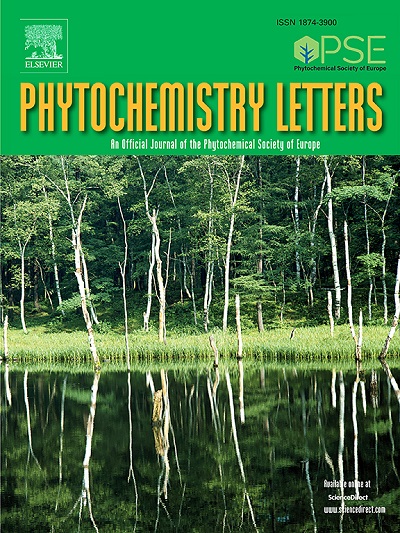Gracilarioside A, New Glycolipid and other cytotoxic constituents from red algae Gracilaria edulis
IF 1.4
4区 生物学
Q4 CHEMISTRY, MEDICINAL
引用次数: 0
Abstract
A comprehensive investigation of chemical constituents from red algae Gracilaria edulis led to the isolation and identification of 12 compounds, which include a new MGDG (Mono Galactosyl Diacyl Glycerol) glycolipid, Gracilarioside A (1) alongside with two known cerebrosides (2, 3), sterols (4-7), nitrogen bases (8, 9) and nucleosides (10-12). The structures of isolated compounds were elucidated by extensive spectroscopic techniques, (IR, MS, and 2D NMR) and single crystal X-ray diffraction studies. The crystal structure of 4 was reported for the first time. Further, anticancer activities of the extract and isolated compounds were assessed against a panel of cancer cell lines including DU145 (prostate), B16F10 (melanoma), HeLa (cervical), and MDA-MB 231 (breast) using MTT assay. Among the tested compounds, compounds 1, 3, 4, 7 and 8 displayed significant activities against MDA MB 231 [IC50, 7.47 ± 0.05, 7.64 ± 0.34, 6.59 ± 0.21, 6.38 ± 0.49 and 7.19 ± 0.03 µM] while compounds 4, 5, 6 and 7 manifested moderate activities against B16F10 [7.0 ± 0.35, 7.20 ± 0.25, 7.26 ± 0.18 and 5.33 ± 0.04 µM] cell lines, respectively. Given their notable activity, compounds 1, 3 and 4 were chosen for further investigation through detailed fluorescence assays, DCDFA assay and scratch assays against MDA MB-231 cell lines which suggested the induced cell death by apoptosis. Overall, the significant findings suggest that these compounds could be promising lead molecules in the development of new anticancer drug candidates.
红藻江蓠苷A、新糖脂及其他细胞毒性成分
从红藻中分离鉴定了12种化合物,其中包括一种新的MGDG(单半乳糖二酰基甘油)糖脂、葛花叶苷A(1)以及两种已知的脑苷(2,3)、甾醇(4-7)、氮碱(8,9)和核苷(10-12)。分离化合物的结构通过广泛的光谱技术(红外、质谱和二维核磁共振)和单晶x射线衍射研究得以阐明。4的晶体结构为首次报道。此外,采用MTT法对包括DU145(前列腺)、B16F10(黑色素瘤)、HeLa(宫颈癌)和MDA-MB 231(乳腺癌)在内的一系列癌细胞系进行了抗癌活性评估。测试化合物,化合物1、3、4、7和8显示重大活动对MDA 231 MB (IC50, 7.47 ± 0.05,7.64 ± 0.34,6.59 ± 0.21,6.38 ± 0.49和7.19±0.03 µM]而化合物4、5、6和7显示中度活动对B16F10[7.0 ± 0.35,7.20 ± 0.25,7.26 ± 0.18和5.33±0.04 µM]细胞系,分别。考虑到化合物1、3和4具有明显的活性,我们选择化合物1、3和4对MDA MB-231细胞株进行了详细的荧光实验、DCDFA实验和划痕实验,结果表明化合物1、3和4具有诱导细胞凋亡的作用。总的来说,这些重要的发现表明,这些化合物可能是开发新的抗癌候选药物的有希望的先导分子。
本文章由计算机程序翻译,如有差异,请以英文原文为准。
求助全文
约1分钟内获得全文
求助全文
来源期刊

Phytochemistry Letters
生物-生化与分子生物学
CiteScore
3.00
自引率
11.80%
发文量
190
审稿时长
34 days
期刊介绍:
Phytochemistry Letters invites rapid communications on all aspects of natural product research including:
• Structural elucidation of natural products
• Analytical evaluation of herbal medicines
• Clinical efficacy, safety and pharmacovigilance of herbal medicines
• Natural product biosynthesis
• Natural product synthesis and chemical modification
• Natural product metabolism
• Chemical ecology
• Biotechnology
• Bioassay-guided isolation
• Pharmacognosy
• Pharmacology of natural products
• Metabolomics
• Ethnobotany and traditional usage
• Genetics of natural products
Manuscripts that detail the isolation of just one new compound are not substantial enough to be sent out of review and are out of scope. Furthermore, where pharmacology has been performed on one new compound to increase the amount of novel data, the pharmacology must be substantial and/or related to the medicinal use of the producing organism.
 求助内容:
求助内容: 应助结果提醒方式:
应助结果提醒方式:


